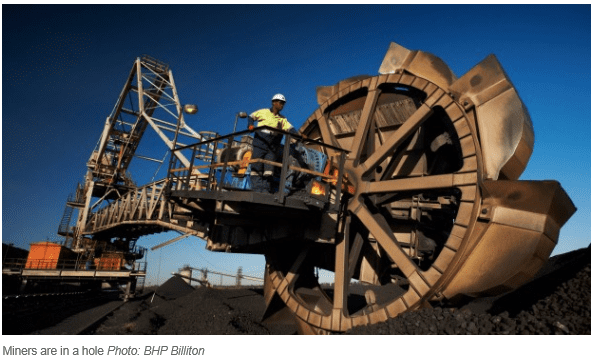
Australian resources stocks were rocked in the wake of British-listed miner Glencore’s catastrophic share price plunge on Tuesday, with local miners leading a brutal $50 billion sell-off.
Shares in Australia’s biggest mining company, BHP Billiton, fell to their lowest point since November 2008 on Tuesday, down 6.65 per cent to $21.61. The losses followed a 6 per cent overnight plunge in its UK-listed body.
BHP’s previous share price nadir came during the depths of the global financial crisis, but in normalised trade its shares are now at their worst since 2006.
Rival miner Rio Tinto’s shares also plunged in London, and were down 4.57 per cent on the ASX to $46.52, marking a multi-year low. Meanwhile, Fortescue Metals Group fell 5.6 per cent to $1.68.
Energy companies were also battered. Origin Energy fell 10.43 per cent to $6.10 while Santos lost 9.13 per cent to close at $4.28.
The fall in the resources stocks led a broad-based sell-off on the benchmark S&P/ASX 200, reversing a strong rally on Monday and sending the benchmark to a close at 4918 points and a fresh two-year low.
Glencore’s shares had earlier plummeted to an all-time low since its $US60 billion listing in 2011, falling almost 30 per cent on the London Stock Exchange to just 68.62p. Its year-to-date share price falls are in the order of 77 per cent.
Rather than company news sparking the plunge, an analyst assessment that if commodity prices remained low Glencore’s equity value was virtually worthless sent shares spiralling.
“At current spot prices, all else being the same, Glencore’s equity value is zero,” analysts at British-based Investec said on Monday.
Perth-based Katana Asset Management portfolio manager Romano Sala Tenna said the ASX’s broad sell-off reflected wider concerns that Glencore’s woes had only exacerbated.
“I think there’s general concern around what’s happening in China, [August was] the worst month for profitability in quite a number of years,” he said.
China’s industrial profits fell 8.8 per cent in August compared to the previous year, extending falls in July amid China’s economic slowdown.
“There is also general nervousness around emerging markets like Brazil, and Janet Yellen putting off an interest rate rise [in the US] which she had the perfect opportunity to do,” Mr Sala Tenna said.
Mr Sala Tenna said Glencore’s debt pile compared to its market capitalisation was creating “a real issue” that made it difficult for it to recover from.
“Glencore has somewhere in the vicinity of $US45 billion in liabilities but a market cap of $US14 billion, that’s a really nasty position to be in,” he said.
“Added to the mix is the fact that coal is where it has built a lot of its foundations and of course coal could not be more on the nose,” he said.
It was difficult to see the outlook for coal improving given the weak Chinese demand, Mr Sala Tenna said.
“The mining industry as a whole is in a pretty dark place,” UBS commodities analyst Daniel Morgan said.
He said demand for commodities had been weaker than expected at the start of the year, and most commodity markets were sitting in surplus,
The recent falls in commodity prices has led the weighting of miners and mining-related companies on the ASX 200 to fall to 14 per cent, its lowest level since 2002 and down from their peak of more than 30 per cent in 2008.
Glencore’s investors are losing faith in the ability of the company, led by chief executive officer Ivan Glasenberg, to execute its $US10 billion debt-reduction plan amid the commodity rout.
IG market strategist Evan Lucas said working against the company was that huge asset sale deals usually moved “at a snail’s pace”.
“In the meantime, the market is moving so rapidly, wiping off huge swaths of asset value. By the time these deals are done, Glencore’s credit rating could be junk status,” he said.
But the contagion effects on BHP and Rio were overdone, as the two biggest Australian miners were in a much stronger position, Mr Sala Tenna said.
A blow-out in credit default swaps of the miners, while less than Glencore, was to be expected, he said, as “people shoot first and ask questions later”.
“In their chosen commodities, we’re talking about iron ore, they’re so far down the cost curve that this is probably pretty close to as bad as it gets for BHP and Rio in terms of profitability, yet they’re still very highly profitable at these levels.
“Fundamentally I think our miners have come through in much better shape.”
While BHP was beginning to look oversold, and rapidly becoming the highest-yielding stock on the ASX, at 7.7 per cent fully franked and 11 per cent fully grossed, it was too soon to call the bottom of the commodity rout.
